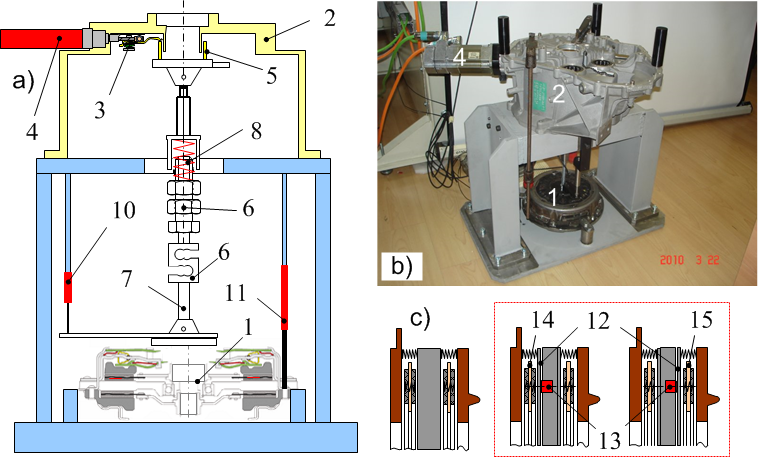Dry dual clutch axial subsystem
The test rig of dry dual clutch (1) axial subsystem is suitable for characterization of (i) the clutch actuator (3) under realistic loading conditions provided by the dual clutch (cf. the actuator rig with spring load) and (ii) the dual clutch axial dynamics themselves. The two subsystems are axially displaced in order to accommodate the engagement bearing (5) force measurement. They are connected by means of a strain gauge sensor (6) and appropriate custom-made fixing elements for each clutch (7). Similar to actuator rig, a linear helical compression spring (8) and an adjustment mechanism (9) are added in order to provide manual variation of the clutch preload or the clearance between the engagement bearing and the clutch.
Two LVDT displacement sensors are used to measure the engagement bearing position (10) and the pressure plate position (11). The flywheel has been modified to provide the clutch normal force measurement (see Fig. c). The normal force is sensed by measuring a reaction force in one of three supporting points of a custom made clutch reaction plate (12). Three circularly equally spaced blind holes have been drilled on the same radius in order to accommodate space for the force sensor (13) and two steel "dummy" sensors. The steel reaction plate has been inserted between the support point and the clutch friction plate (14, 15) in order to provide uniform load distribution among the support points. The modified flywheel can be assembled in two ways (Fig. c), thus enabling characterization of both clutches.

2. Clutch bell housing
3. Actuator
4. Servomotor w/ spindle drive
5. Engagement bearing
6. Strain-gauge force sensor
7. Fixing elements
8. Compression spring
9. Adjustment mechanism
10. Engagement bearing displacement sensor
11. Press plate displacement sensor
12. Custom made clutch reaction plate
13. Force sensor
14., 15. Clutch friction plates
Fig. 1. Schematics and photographs of test rigs of dry dual clutch axial subsystem.
Publications
-
SAE paper #2012-01-0807, SAE International Journal of Passenger Cars - Mechanical Systems, Vol. 5, No. 1, pp. 612-620, 2012.